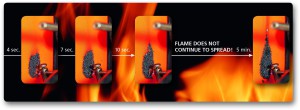 With the pyroshell™ technology, Schoeller Textil AG has succeeded in uniting permanent flame protection with polyamide or polyester fabrics. pyroshell™ offers the type of flame protection which is now required for personal protective equipment in many branches of industry. This means that security staff, railway workers, police officers, staff in power stations, military personnel and workers in the oil and gas industry are ideally protected when they come into contact with fire and sparks.
With the pyroshell™ technology, Schoeller Textil AG has succeeded in uniting permanent flame protection with polyamide or polyester fabrics. pyroshell™ offers the type of flame protection which is now required for personal protective equipment in many branches of industry. This means that security staff, railway workers, police officers, staff in power stations, military personnel and workers in the oil and gas industry are ideally protected when they come into contact with fire and sparks.
pyroshellTM technology facilitates permanent flame protection on synthetic fabrics without the use of conventional and often environmentally harmful flame retardants or additives and is produced in accordance with the bluesign® standard. The familiar benefits of synthetic functional fabrics based on polyamide or polyester are retained in full such as clothing comfort, breathability, tear resistance, abrasion resistance, lightness, elasticity or ease of care, to mention just a few of the positive properties. A particularly outstanding feature is the fact that when used on suitable polyester fabrics, excellent safety results in terms of flame protection and visibility can now also be achieved in all the colors for EN 471 high-visibility clothing – neon yellow, neon orange and neon red.
When a fabric with pyroshellTM technology is exposed to a flame, a physical process triggers a major increase in volume. The layer thus created naturally displays a greatly-reduced specific density so that both heat and the gasses which promote burning – such as oxygen and the flame’s free radicals – are widely repelled by the fabric. First tests with conventional flame protection fabrics of a similar weight, with flame impingement applied over 10 seconds in accordance with EN ISO 15025 show an approx. 100 °C lower temperature increase on the next-to-skin side of the fabric. In addition to the EN ISO 15025 flame test, the thermal transfer index for convective heat – Code B in accordance with ISO 9151 – as well as the thermal transfer index for radiant heat – Code C in accordance with ISO 6942 – are also tested in the context of EN ISO 11612.




